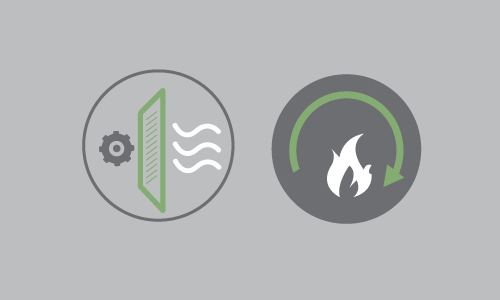“Energy can neither be created or destroyed, just changed from one form to another.” For manufacturers, this is a given—it’s not only the first rule of thermodynamics, it’s the basis of operating an oven, dryer, or pollution control system: Energy from a fuel source is transformed and applied to an object in order to achieve the desired result. Whether the goal is to bake, cure, or destroy pollutants, the process is the same: Convert potential energy stored in a fuel source through combustion and apply it to achieve a desired result.
Not Created or Destroyed—Reusing Heat to Reduce Operating Costs
However, once you’ve used the energy, what happens? Often this depends on whether or not there are processes in place to capture and reuse the heat. The question, of course is this: Why waste energy?
In 2018, two things hold true. Fuel prices are going to start rebounding, resulting in higher operating costs to produce goods or operate a pollution control system. Additionally, society has become more and more in tune with the environmental impact of firms and people have already started to search for firms that align with their expectations of corporate citizenship.
Knowing the weight that these two factors present in your bottom line, it makes good business sense to remember the three R’s: Reduce, reuse, and recycle. Luckily, you can reduce fuel use by reusing and recycling previously uncaptured energy to power your manufacturing processes. How? By using an energy recovery system.
Energy Recovery: “Free” Energy for Your Operations
As mentioned above, you have to apply a lot of energy if you hope to run an oven, dryer, or pollution control system. Generating this energy requires fuel—often in the form of petroleum, natural gas, or electricity. However, by utilizing an energy recovery system you can capture some of the energy generated and apply it to other processes.
There are many uses for energy recovery, all of which accomplish the same goal: reducing operating costs. A recent article in Process Heating went as far as calling waste heat “free energy,” stating that even if there is a cost to ‘create’ the energy, you’re recapturing heat that would otherwise escape through a stack. Below, we will discuss with you the types of energy recovery solutions and how they can be used to reduce operating costs and improve your bottom line.
Three Ways to Apply Otherwise Unused Waste Heat
While there are examples of directly reapplying heat within a single application (Thermal Recuperative Oxidizers continually apply heat generated during the oxidation process through a heat exchanger to preheat process air), the process of energy recovery has a much more diverse set of applications. Whether in the form of air-to-air, air-to liquid, or air-to-waste, waste heat can serve many purposes from preheating to providing ambient heat.
Air-to-Air Heat Recovery Systems
An air-to-air secondary heat exchanger can be an extremely efficient low cost solution to capturing heat from an exhaust stack. The heat exchanger can be designed for minimal pressure drop so as not to affect the operation of the upstream system while returning temperature controlled fresh-air back to the facility for a variety of uses, including:
- Heat recovery for preheating the same process or other processes.
- Combustion air preheating.
- Oven/furnace makeup air preheating.
- Fume preheat on catalytic/recuperative thermal oxidizers.
- Secondary heat recovery on regenerative oxidizers.
- Heat exchange and recovery for volatile organic compound (VOC) concentrators.
Air-to-Liquid Heat Recovery Systems
An air-to-liquid primary heat transfer coil can be installed within the equipment exhaust stack to capture heat from an exhaust stream and provide hot water, glycol or hot thermal oil.
Using secondary air-to-liquid or liquid-to-liquid coils with an integrated liquid pump skid, the heated liquid can be used throughout a facility for building comfort heat, process make-up air (ovens/dryers, kilns, curing zones, etc.) or to provide supplemental heat to boilers, hot water wash systems, etc.
Air-to-Waste Heat Boiler Energy Systems
Depending on the exhaust stack temperature, the exhaust from the process equipment could also be routed directly to a low-pressure waste heat boiler.
The CMM Group: Specialists in Energy Recovery and Application
At The CMM Group, we have been in the business of designing, manufacturing, and implementing process heating solutions for clients for nearly 20 years. From oxidizers to ovens to energy recovery systems, we know the importance of running a facility as efficiently, sustainably, and affordably as possible, and have worked with manufacturers of all sizes to provide solutions for their facilities. We welcome you to learn more about our energy recovery solutions and to request a quote here.




